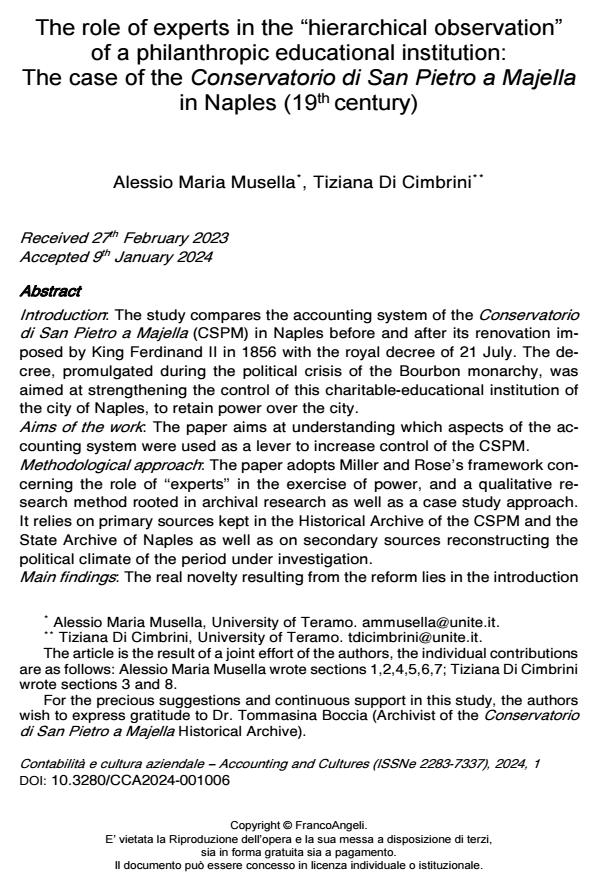The role of experts in the “hierarchical observation” of a philanthropic educational institution: The case of the Conservatorio di San Pietro a Majella in Naples (19th century)
Titolo Rivista CONTABILITÀ E CULTURA AZIENDALE
Autori/Curatori Alessio Maria Musella, Tiziana Di Cimbrini
Anno di pubblicazione 2024 Fascicolo 2024/1
Lingua Inglese Numero pagine 30 P. 103-132 Dimensione file 450 KB
DOI 10.3280/CCA2024-001006
Il DOI è il codice a barre della proprietà intellettuale: per saperne di più
clicca qui
Qui sotto puoi vedere in anteprima la prima pagina di questo articolo.
Se questo articolo ti interessa, lo puoi acquistare (e scaricare in formato pdf) seguendo le facili indicazioni per acquistare il download credit. Acquista Download Credits per scaricare questo Articolo in formato PDF

FrancoAngeli è membro della Publishers International Linking Association, Inc (PILA)associazione indipendente e non profit per facilitare (attraverso i servizi tecnologici implementati da CrossRef.org) l’accesso degli studiosi ai contenuti digitali nelle pubblicazioni professionali e scientifiche
Introduction: The study compares the accounting system of the Conservatorio di San Pietro a Majella (CSPM) in Naples before and after its renovation imposed by King Ferdinand II in 1856 with the royal decree of 21 July. The decree, promulgated during the political crisis of the Bourbon monarchy, was aimed at strengthening the control of this charitable-educational institution of the city of Naples, to retain power over the city. Aims of the work: The paper aims at understanding which aspects of the accounting system were used as a lever to increase control of the CSPM. Methodological approach: The paper adopts Miller and Rose’s framework concerning the role of “experts” in the exercise of power, and a qualitative research method rooted in archival research as well as a case study approach. It relies on primary sources kept in the Historical Archive of the CSPM and the State Archive of Naples as well as on secondary sources reconstructing the political climate of the period under investigation. Main findings: The real novelty resulting from the reform lies in the introduction of experts into the apparatus of accounting surveillance on the CSPM, making the case study an example of the use of experts for control by political power.
Parole chiave:accounting, charities, performing arts, governmentality, nineteenth century, Italy.
Alessio Maria Musella, Tiziana Di Cimbrini, The role of experts in the “hierarchical observation” of a philanthropic educational institution: The case of the Conservatorio di San Pietro a Majella in Naples (19th century) in "CONTABILITÀ E CULTURA AZIENDALE" 1/2024, pp 103-132, DOI: 10.3280/CCA2024-001006